DriveSure
Does Your Dealership Have a Customer Feedback Loop?
It seems obvious: Customers tell you what they like or don’t like. Your dealership does more or less of those things. At a basic level, that’s right. But dealerships need more intentionality when it comes to customer feedback. They need to be able to take action and show their customers they’re committed to continual improvement and listening.
That’s where customer feedback loops enter the picture.
A customer feedback loop is an approach to gathering insights on a continual basis, so your dealership can keep its finger on the pulse of your customer base and improve its overall experience. Many dealerships send surveys or have casual conversations with their customers. Customer feedback loops take these efforts to the next level to ensure you’re constantly receiving and responding to customer feedback.
As we’ll talk about later, the key point for a successful customer feedback loop is “responding.” Without meaningful action from your dealership – aka closing the loop – it fails to be a feedback loop at all.
Let’s take a closer look at customer feedback loops and why your dealership should have one.
The Importance of a Customer Feedback Loop
Customer feedback loops drive loyalty and retention. Customers want to know they have a voice at your dealership and that you’re willing to listen to them. Show them you’re all about taking action to improve their experience and they’ll keep coming back. They’ll also tell their friends and family to buy from your dealership.
“Customer feedback is the breakfast of champions.” - Brian Halligan, co-founder of HubSpot & renowned business leader
Customer feedback loops are important to dealerships because they establish a scalable system for making customers feel heard. They go beyond merely asking for feedback; customer feedback loops end with a solution and an affirmation to the customer that their thoughts led to a positive change.
Customer feedback loops are essential because customer loyalty is essential. Their value is that simple.
The Stages of a Customer Feedback Loop
1. Gather: Surveys are a natural starting point for gathering data. Using a survey platform to do this can be beneficial because they’re easy to build and share – and they sometimes offer instant analysis of the results. Gathering feedback can be done via email, dealer management systems, live chats, and even social media.
Understanding when to source customer feedback is the key at this stage.
Think about the different touchpoints where a customer is most likely to have an emotional response (good or bad) to your dealership. At what points in their visit are customers deciding to buy or not? At what points are they deciding they’ll return or not?
An example strategy for gathering data in a customer feedback loop may begin with a survey about a service visit. You set up an automation, likely using an email integration with your dealer management system, to send each service customer a satisfaction survey one hour after their visit. Once the customer completes the survey, another automated email is sent to them as a “thank you” for their time – potentially including a small dealership store credit.
While this outreach can be done manually, it’s a huge challenge to scale. Just like with requesting customer reviews, automated email campaigns are effective and easy to create.
2. Analyze: Once you’ve gathered enough data to make reasonable conclusions about your customer satisfaction, it’s time to analyze. Your dealership may also consider setting up a quarterly cadence for performing these analyses. First, break out your customer feedback by category – for example, service insights vs. sales insights. Then, your dealership can review feedback in an intentional and actionable way.
Hopefully the tools you’re using have built-in analytics. Either way, you’re looking for common themes here. Are you receiving the same complaints about service wait times? Do customers rave about the same salesperson? These are the kinds of questions you’ll ask yourself as you analyze customer feedback.
3. Implement: As mentioned earlier, this fails to be a “loop” without action from your dealership. That means implementing insights from your customer feedback – or closing the loop – through solutions. If you’ve determined a need, such as decreasing service wait times, start working towards a strategy with your team.
An important point at this stage is to communicate with your customers. Set the tone that your dealership is dedicated to their satisfaction by letting them know a solution is in the works as a result of their feedback. Once the solution has been implemented, again make sure customers know that it was a result of their feedback.
Action and communication fuel customer feedback loops (and thus loyalty).
4. Revisit: Without customer feedback loops, old problems can quickly become new problems. In the analyze stage, watch out for common customer complaints that have returned. Track the performance and reception of new solutions. Ask your customers in the gather stage for their thoughts on the solutions you’ve already implemented as a result of their feedback. As the name suggests, customer feedback loops depend on constant connection throughout the stages.
Closing a Customer Feedback Loop
The benefits and stages of a customer feedback loop are all well-documented. But as you read more about this topic, you’ll run into the idea of “closing” your customer feedback loop.
Wait, why would you want to close your customer feedback loop?
Closing the customer feedback loop simply means you’ve notified customers a change has been made to your dealership’s offerings directly based on their feedback. Going back to the main theme of customer feedback loops, you’re putting a cap on the process by telling them they were heard. You’re telling them their feedback mattered.
Ready to kickstart and close your customer feedback loop?
Get this guide to the customer journey first, so your dealership can better understand the most common moments dealerships lose customers. These are great places to start focusing on feedback.
DriveSure
Is Your Service Department Experience One for All Ages?
Most new car dealerships know that getting customers to return for service is critical to success —  both for maximizing fixed ops profits, and for generating new car sales through repeat buyers. After all, the service and parts department accounts for 49.6% of the dealership's gross profits, according to NADA.
both for maximizing fixed ops profits, and for generating new car sales through repeat buyers. After all, the service and parts department accounts for 49.6% of the dealership's gross profits, according to NADA.
Knowing the importance and strong connection of the service department to the dealer’s bottom line, DriveSure recently conducted a survey to better understand why vehicle owners return for service—and why they don’t. Breaking the responses down by age uncovered some interesting similarities and differences across generations.
Viewing the Data Through an Age-Segmented Lens
In addition to several important takeaways for service department managers and fixed ops directors, we uncovered some valuable insights on how the age of your customers affects their outlook and experience.
Let’s break down a few of the key findings, then go a step further by viewing the data through a generational lens.
What brings customers into dealerships…and what drives them away?
When asked which factors are most important in getting them to return for service, quality of work, price, and quality of customer service were the top three choices—with older customer segments less likely to care about price and more likely to value the quality of work and service.
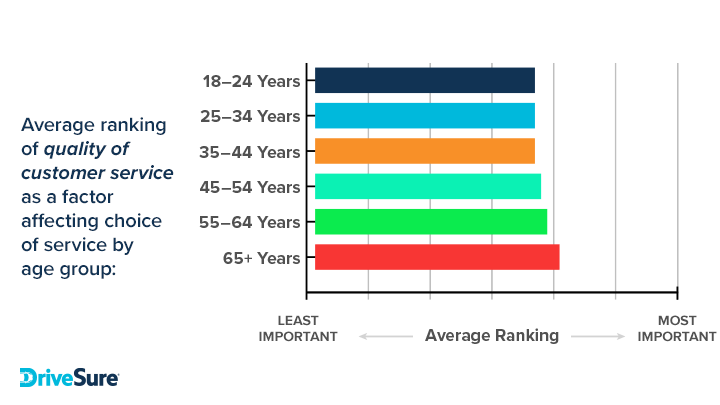
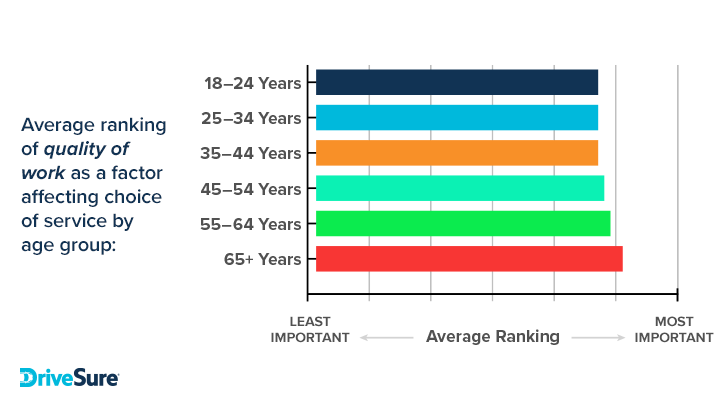
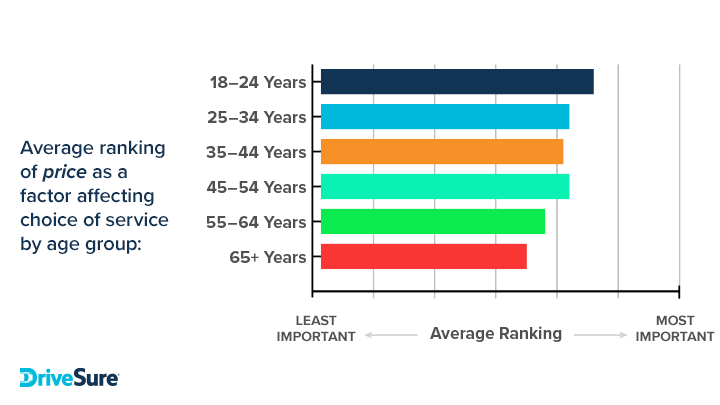
Because most dealership service departments already pride themselves on providing superior quality of work and customer service, this is reassuring for all of your customer age groups. Keep in mind though, that regardless of age or loyalty, many will look elsewhere for service after just one bad experience.
And while knowing that price is important to your younger segments underscores the threat your low-cost competitors pose, there are ways to mitigate this. Like ensuring your amenities meet the diverse needs of your customer base…
What service department amenities do your customers value most?
Customers 34 and younger value online appointment booking with vehicle pickup and delivery cracking their top three.
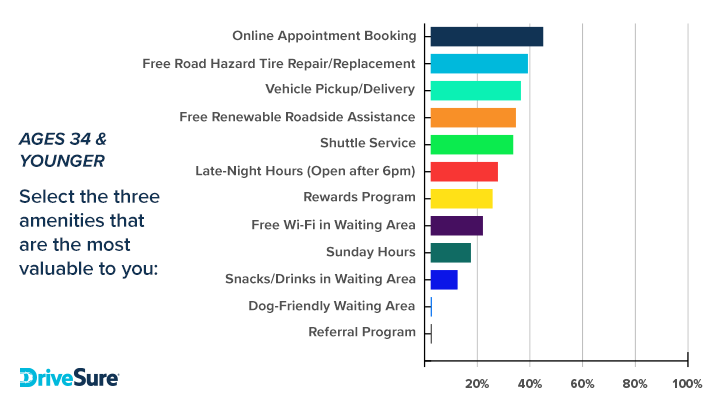
For those aged 35 to 54, vehicle pickup and delivery remained important, but shuttle service dropped significantly, highly valued by just 22 percent of people in that age group.
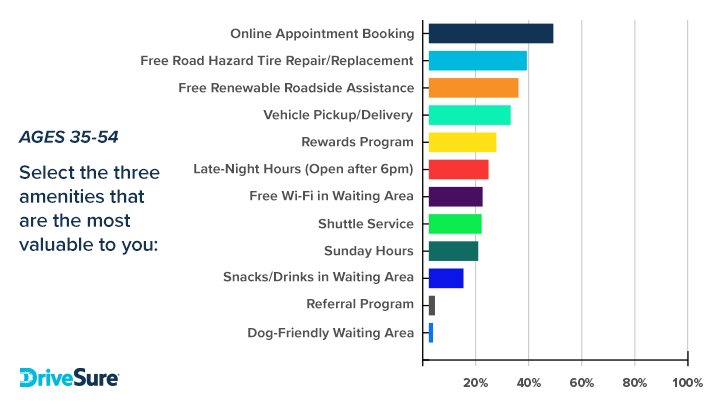
Understandably, shuttles jump back up to the third most valued amenity for those 55 and over.
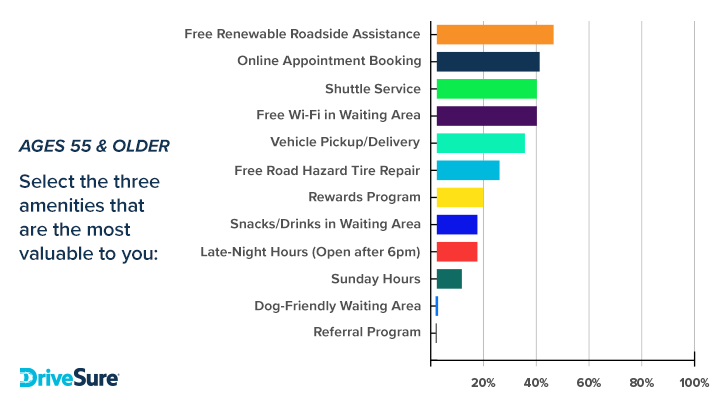
In a bit of a surprising twist, respondents 55 and above have a strong preference for online appointment booking (41%) and even free Wi-Fi in the waiting area (26%).
Bottom line: vehicle pickup and delivery is an essential amenity—especially after COVID-19—and no matter the age of your customer, technology-related amenities are an attractive incentive that ranks high on the list of what your customers want.
What are the preferred communication channels between and during visits?
When it comes to communication between visits—be it general updates, news, or appointment reminders—email reigns supreme for all age groups, followed by texting.
For the 55+ age group, the difference is significant (60 percent prefer email and just 23 percent want to receive text messages).
But the gap narrows significantly for participants 34 and younger, with only four percentage points between the two options. Interestingly, this age group is more likely to prefer phone calls between visits (16%).
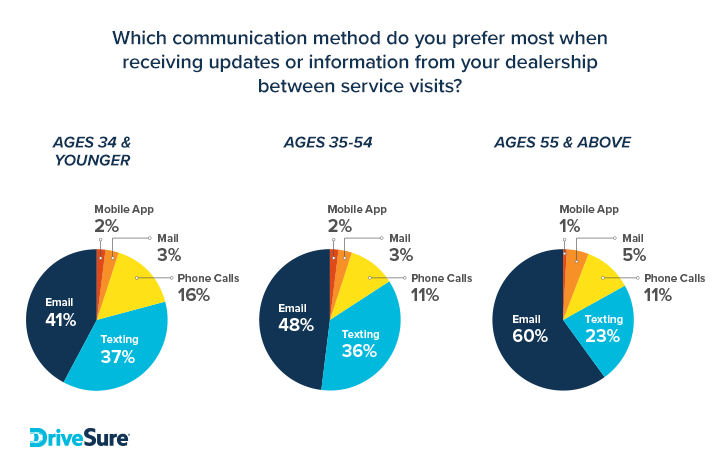
In regards to communication during visits, texting is the clear winner across the board.
A wide gap exists even for consumers 55 and older (the group with the highest portion of people who prefer calls). In this age group, over half still prefer text messages (54%), while only 27 percent prefer calls.
The (SMS) message here is loud and clear…
If you haven’t already, now is the time to fully embrace text messaging for communicating with customers.
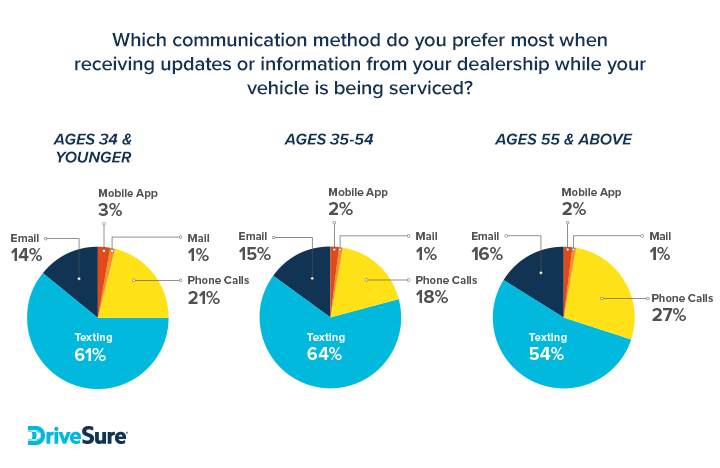
Are your customers open to more modern forms of communication like smartphone apps?
As a matter of fact, they are. And while there is a predictable disparity between the level of enthusiasm among different age groups, an impressive 45 percent of consumers 55 and older said they are “likely” or “very likely” to download an app from your service department.
Unsurprisingly, the percentage of willing app participants jumps to about 60 percent for the younger segments.
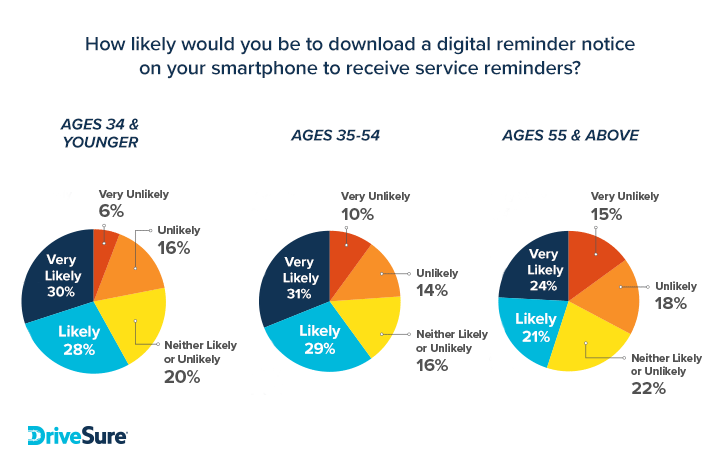
How Does Your Service Department Stack Up?
The good news is, there aren’t substantial deviations among service department customer preferences by age group. There are differences, though, and ensuring you accommodate and fill the gaps can make a big difference in the profitability of your service department.
Ultimately, we firmly believe that dealership service department customer service should be a relationship-based experience. The survey results certainly tell us that much, and if you focus on providing a superior (and personal) experience, customers of all generations are more likely to be satisfied.
For a much deeper dive and complete breakdown of the full survey results, get your copy of the Dealership Service Retention Report today.
Bill Springer has been helping dealerships grow their business at Krex, Inc. since 1987. As President of the organization, he is dedicated to helping service and sales departments provide unbeatable value to their customers. Krex’s signature solution, DriveSure, is specifically designed to make dealerships the only provider car owners depend on for maintenance, tires, and repairs.
No Comments
No Comments